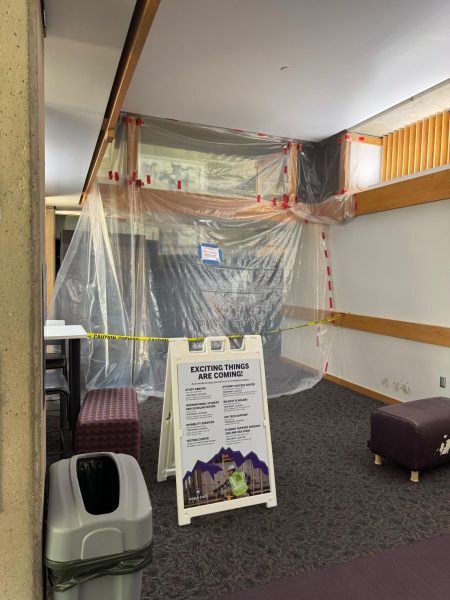The drying times of The Great Salt Lake
The once “Great” Salt Lake is dying, the Utah Division of Wildlife Services revealed in a report. The report notes that the lake has lost 44% of its surface area since 1875. DWR also estimates water levels have dropped 11 feet due to human diversions. In fact, the northeast arm of the lake near Ogden and Willard Bay, is almost completely dried up.
“Most recent data within water-surface elevations show a downward trend,” DWR said, in a report. “With climate change and Utah’s ever growing human population, we expect this negative trend to continue.”
Weber State University is hosting the Walker Civic Symposium: The State of the Great Salt Lake to discuss the issues with the Great Salt Lake and what legislation might be happening to remedy the situation. The event will be held Friday, November 4, at 1:30 p.m. in Lindquist Hall room 101. Utah House Representative Brad Wilson will be speaking and hosting a question and answer session with those in attendance. Students can register for the event on the GivePulse app or website.
One of the biggest effects on human health the Great Salt Lake drying up poses is toxic dust plumes originating from the lake bed.
Kevin Perry, professor of atmospheric sciences at the University of Utah, conducted a study on the dry lake bed.
The study found nine minerals in the soil of the Great Salt Lake that exceeded levels determined safe by the U.S. Environmental Protection Agency. These nine minerals were antimony, arsenic, cobalt, copper, lanthanum, lithium, manganese, vanadium and zirconium.
Three of the aforementioned minerals are especially concerning due to the health risks involved with them.
According to a World Health Organization report, arsenic exposure in humans can cause skin lesions, cardiovascular disease, diabetes and cancer. This report also mentions that exposure to vanadium can cause lung damage.
Prolonged exposure to cobalt is also quite damaging. It can cause cancer and harm the eyes, skin, lungs and heart, according to a Center for Disease Control case study.
These cancer-causing minerals can be picked up by winds and create toxic dust plumes. In the study done by Perry, he says, “Approximately 9% of the Great Salt Lake bed currently produces dust plumes under appropriate meteorological conditions.”
Perry also notes that this number could rise to 22% if protective vegetation and crusts are damaged or eroded away.
The report states that “four of the elements measured had some values which exceeded both the residential and industrial RSLs established by the EPA.” RSLs, or Regional Screening Levels, determine how levels of certain contaminants compare in residential and industrial areas around the country.
It also details the effects of these dust plumes on the climate. As the minerals in the dust settle on the mountainside, this causes accelerated snowmelt.
With Utah already experiencing droughts, the snow melting faster could worsen the state water supply. Surrounding climates and ecosystems are also feeling the effects of the accelerated water loss.
Antelope Island, the largest island in the Great Salt Lake, is slowly losing the island title. With water levels hitting historic lows, a land bridge has surfaced between the southern part of the island and the adjacent salt flats, making it more of a peninsula than an island. This could pose a threat to the local wildlife that call the island home.
Fencing is being placed on the land bridge to deter the buffalo, bighorn sheep and other local animals from migrating and mingling with farm animals and contracting diseases.
In 2018, the Utah Division of Wildlife Resources reported that the herd on Antelope Island had been completely decimated by a respiratory disease. The herd has since been reintroduced to the island, and is used as a nursery to help supplement the local bighorn population.
As water levels fall, the salinity of the water increases, making the salt more concentrated in the lake.
This has the potential to harm the brine shrimp population. Brine shrimp are a major food supply for birds in the area and are harvested and sold to make fish and shellfish food. The Utah Division of Wildlife Services estimates that the brine shrimp industry generates anywhere from $10 million to $60 million annually.
The Great Salt Lake is one of many terminal saltwater lakes worldwide, meaning it is a lake that does not have any outlets. Lake Urmia, a saltwater lake with no outlets in Iran, went through a very similar situation to what is happening in Utah.
In 2014, Lake Urmia had reduced to just 10% of its maximum capacity, according to the U.S. Department of the Interior. Following the drying of the lake, dust storms containing cancer-causing minerals began causing an issue. These dust storms have the potential to harm human and animal health, as well as kill vegetation and farming crops.
Since then, Iran has taken steps and enacted regulations to help replenish the water levels in the lake. NASA imaging from the International Space Station shows the surface area of the lake rising, so there are hopes that the lake will be able to recover to its full capacity and continue to harbor wildlife.








